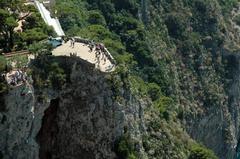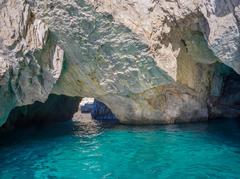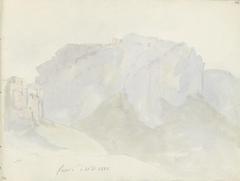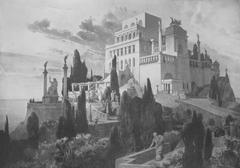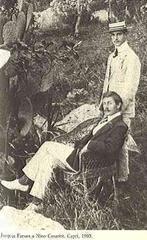Palazzo a Mare: Visiting Hours, Tickets, and Comprehensive Guide to Capri’s Historical Gem
Date: 04/07/2025
Introduction
Palazzo a Mare, or “Sea Palace,” is one of Capri’s most iconic archaeological sites—a remarkable testament to Roman imperial luxury set against the island’s stunning northern coast. Originally commissioned by Emperor Augustus and expanded by Tiberius, this villa complex blends grand ancient architecture with breathtaking natural scenery, inviting visitors to explore a world where history, leisure, and beauty converge (Wikipedia; Capri.com). This guide provides up-to-date information on visiting hours, ticketing, accessibility, and travel tips, ensuring you have everything needed for an immersive experience at Palazzo a Mare and its surroundings.
Table of Contents
- Introduction
- Historical Overview
- Site Layout and Setting
- Construction Techniques and Materials
- Key Architectural Features
- Archaeological Remains and Excavations
- Integration with the Landscape
- Visiting Hours, Tickets & Accessibility
- How to Reach Palazzo a Mare
- Facilities and Dining
- Guided Tours, Special Events & Photography
- Cultural and Geoarchaeological Significance
- Preservation and Research
- Impact on Capri’s Tourism and Local Traditions
- Practical Visitor Information & Etiquette
- FAQs
- Conclusion and Call to Action
- References
Historical Overview
Imperial Origins and Patronage
Built on Capri’s northern shore, Palazzo a Mare was among several imperial villas that transformed the island into a Roman retreat. Augustus (27 BCE–14 CE) first commissioned the villa, drawn by Capri’s scenery and tranquility (Oebalus). His successor, Emperor Tiberius (14–37 CE), expanded the villa, adding monumental architecture and innovative engineering, making it a favored imperial residence (Capri.com).
From Decline to Rediscovery
Over the centuries, Palazzo a Mare endured looting, especially by the Austrian Hadrawa in the 18th century, and suffered damage during the Napoleonic wars. Excavations in the 20th century revealed its grandeur, with terraced walls, cisterns, and partially submerged ruins still visible today (Simply Amalfi Coast).
Site Layout and Setting
Palazzo a Mare occupies a panoramic stretch from Punta Bevaro to Bagni di Tiberio, with terraces cascading toward the Gulf of Naples (Capri Notizie). This layout, typical of Roman maritime villas, maximizes both views and sea access.
Construction Techniques and Materials
The villa features robust retaining walls built in opus reticulatum, a Roman technique using a net-like pattern of small stones. Marble floors, mosaic pavements, and marble-clad impluvia (rainwater basins) once adorned the residence, though many decorative elements were removed over time (Archaeolist).
Key Architectural Features
Semicircular Nymphaeum (Exedra)
A striking nymphaeum, built halfway up the cliff and visible from the sea, highlights the villa’s sophisticated water features and served as a cool, shaded retreat (Archaeolist).
Terraces and Colonnades
An 80-meter-long colonnaded loggia offered vistas over the Bay of Naples, while interconnected terraces provided elegant transitions between living and leisure spaces (Italy Traveller).
Residential and Service Quarters
Evidence remains of residential rooms, cisterns, mosaic flooring, and rustic quarters—testaments to both opulence and everyday life within the villa (Capri Notizie).
Water Management and Pisciculture
Multiple cisterns collected rainwater, while pools and submerged structures near the shore hint at fish farming and a private harbor (Capri Notizie).
Archaeological Remains and Excavations
Systematic excavations led by Amedeo Maiuri in 1932 unearthed terracing walls, cisterns, and substantial remains of the original villa. Submerged ruins provide further insight into Roman engineering and coastal changes (Archaeolist).
Integration with the Landscape
Palazzo a Mare exemplifies the Roman ideal of harmony between architecture and the natural world, with scattered pavilions and Mediterranean gardens framing spectacular sea views (Capri Notizie).
Visiting Hours, Tickets & Accessibility
- Hours: Open daily, typically 9:00 AM–6:00 PM (seasonal variations possible). Last entry is 30 minutes before closing.
- Tickets: The archaeological area is free to explore. Access to Bagni Tiberio Beach Club facilities requires a reservation and fee (Bagni Tiberio).
- Accessibility: The terrain is uneven. While the shuttle boat from Marina Grande improves accessibility, pathways can be challenging for those with limited mobility.
- Best Time to Visit: Early mornings or late afternoons in spring or autumn for mild weather and fewer crowds.
How to Reach Palazzo a Mare
- On Foot: A scenic 10–15 minute walk from Marina Grande via Via Palazzo a Mare, with some slopes and steps (Bagni Tiberio).
- By Shuttle Boat: Complimentary shuttle for Bagni Tiberio clients from Marina Grande pier, starting at 9:30 AM.
- By Private Boat: Anchor offshore and use tender services.
- By Bus: Capri’s local buses serve nearby areas, but the site is best reached on foot or by boat (Travels with Missy).
Facilities and Dining
Beach and Beach Club
- Bagni Tiberio Beach Club: Reserved sun loungers, umbrellas, changing rooms, showers, snack bar, and restaurant. Reservation highly recommended (Bagni Tiberio).
- Pebble Beach: Free public area with calm, shallow waters—ideal for families and swimmers. Early arrival advised in peak season (Capri.net).
Dining
- Bagni Tiberio Restaurant: Traditional Caprese cuisine with sea views—book ahead.
- Da Paolino: Famous for dining beneath lemon trees—open April–October, reservations essential (Paolino Capri).
Guided Tours, Special Events & Photography
- Guided Tours: Available via local agencies; provide expert context and access to less-visited areas.
- Special Events: Occasional cultural evenings or private tours hosted by Bagni Tiberio Beach Club.
- Photography: Best spots include the nymphaeum, terraces, and shoreline ruins—optimal light at sunrise or sunset.
Cultural and Geoarchaeological Significance
Palazzo a Mare was not just a residence but a symbol of imperial otium—cultivated leisure in harmony with nature. In modern times, it remains integral to Capri’s identity, blending ancient heritage with vibrant local traditions (Isola di Capri Portal). Submerged ruins contribute to geoarchaeological studies, helping reconstruct ancient coastlines and understand environmental changes (Lepenseur Journal).
Preservation and Research
Ongoing archaeological and geoarchaeological research informs conservation strategies, as the site faces erosion, sea-level rise, and the impacts of earlier looting. Integrated efforts seek to preserve and interpret what remains for future generations (Lepenseur Journal).
Impact on Capri’s Tourism and Local Traditions
Palazzo a Mare continues to shape Capri’s tourism, offering both historic intrigue and seaside leisure. Local hospitality traditions, exemplified by family-run businesses like Bagni Tiberio, maintain the spirit of ancient Roman leisure and welcome (Bagni Tiberio History).
Practical Information & Visitor Etiquette
- What to Bring: Swimwear, sun protection, water shoes, camera.
- Rules: Respect archaeological remains; no climbing or removing stones. Dogs are not permitted. Follow dress codes and dispose of litter responsibly.
- Essential Contacts:
- Bagni Tiberio: Via Palazzo a Mare, 41, Capri. Tel: +39 081 837 0703
- Da Paolino: Via Palazzo a Mare, 11, Capri. Tel: +39 081 837 6102
Frequently Asked Questions (FAQ)
Q: Is there an entrance fee?
A: The ruins and public beach are free; beach club facilities require a reservation and fee.
Q: Are guided tours available?
A: Yes, bookable through local agencies or the beach club.
Q: Is the site accessible year-round?
A: The beach is accessible year-round; services like Bagni Tiberio operate from April to September.
Q: Is the site suitable for families?
A: Yes, the calm beach is family-friendly.
Q: Are pets allowed?
A: Dogs are not permitted on the beach or club premises.
Conclusion and Call to Action
Palazzo a Mare offers a captivating blend of history, natural beauty, and local culture. Whether you’re an archaeology enthusiast, a lover of scenic beaches, or a traveler seeking authentic experiences, this site promises a memorable journey through Capri’s imperial past and vibrant present. For the latest updates, guided tours, and exclusive offers, download the Audiala app and follow us on social media.
References
- Wikipedia: Palazzo a Mare
- Oebalus: Roman Villas
- Capri.com: Villas of Tiberius
- Simply Amalfi Coast: Palazzo a Mare
- Scripture Savvy: Da Paolino Restaurant
- Capri.it: Le Ville di Tiberio
- Capri Notizie: Palazzo a Mare, Capri
- Archaeolist: Palazzo a Mare
- Italy Traveller: Imperial Capri
- Isola di Capri Portal: I Bagni di Tiberio e Palazzo a Mare
- Bagni Tiberio History
- Lepenseur Journal: Geoarchaeological Studies
- Travels with Missy: Beach Clubs in Capri
